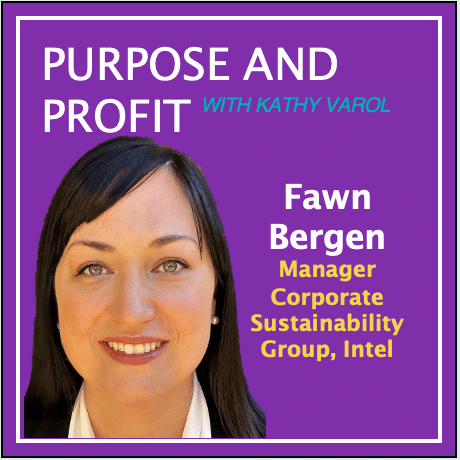Show Notes:
Fawn Bergen leads Intel Corporation’s Corporate Sustainability Group. In her role, Fawn directs the implementation of Intel’s sustainability goals across their manufacturing operations and office facilities around the world, including Intel’s commitments to reach net zero greenhouse gas (GHG) emissions by 2040, 100% renewable electricity by 2030, net positive water by 2030, and zero waste to landfill by 2030.
Fawn’s 24+ years of experience in the environmental field has spanned multiple industries and specialties including air quality engineering, environmental engineering, global strategy, and environmental management roles. Prior to leading Intel’s sustainability group, she led their climate change, water stewardship, and corporate air programs globally.
In this episode we discuss:
✅ Intel’s ESG Framework called RISE
✅ Why water is a key sustainability focus for Intel
✅ How Intel has reached 93% renewable energy across its global operations
3 episode takeaways (listen to the full episode for a lot more gems!):
1️⃣ Gone are the days of vertical integration, which meant a business handled all aspects of production internally, from raw materials to final assembly. The Ford River Rouge complex, completed in 1928 in Dearborn, Michigan, was the largest vertically integrated factory in the world. River Rouge was a mile long and 1.5 miles wide. It contained over 100 miles of internal railroad tracks and housed everything including its own energy plant and steel mill. The factory took raw materials like iron and turned them into fully assembled Fords.
Today companies rely on expansive supply chains to create their products, a horizontal integration across many companies. This change in business structure means there is an interconnectedness across companies and stakeholders when it comes to reaching individual corporate ESG goals. Take greenhouse gas (GHG) emissions as an example. There are 3 different scopes for GHG. Scope 3 emissions tend to be the largest emissions category because it covers all the companies up and down your supply chain whose emissions you are indirectly responsible for. A company can’t reduce Scope 3 emissions without collaborating across the supply chain.
***
2️⃣ If your company is just beginning its ESG journey, consider starting where you have the most control. To be a great corporate partner requires cleaning up your own operations first. Today no company is an island, and the improvements you make to your own operations will make you a better partner by benefitting the footprint of the companies you work with across the supply chain.
* * *
3️⃣ Communities are asking for transparency and accountability from the corporations that operate near their homes. Fawn shared great examples of the questions Intel gets from the communities they operate in, as well as the work they’re doing within these communities. If you don’t know the role your company is playing locally, ask. Challenge your leaders on how your organization can leave the community better off by virtue of being there.
References:
- Connect with Fawn on LinkedIn
- Intel’s RISE Strategy and Goals
- The 2022 CDP A-List
- The Nature Conservancy
- National Forest Foundation
- Trout Unlimited
- World Resources Institute Aqueduct page
- WRI’s fact sheet on Renewable Energy Certificates

